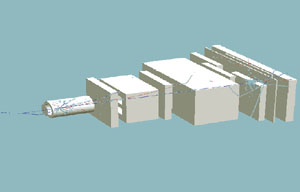
With excitement mounting over new possibilities for “neutrino factories” using muon storage rings, a new experiment at CERN will study in detail the yield of pions produced by high energy protons. The results will provide valuable input to these neutrino factory designs.
The Hadron Production Experiment at the CERN PS proton synchrotron (HARP) is a collaboration of institutes in Austria, Belgium, Bulgaria, France, Italy, Russia, Spain and the UK as well as CERN and the JINR in Dubna, near Moscow.
For a neutrino factory, an intense proton driver accelerator would pile several megawatts of beam power into a specially designed target to make pions, which would then be magnetically collected. These pions would then decay into muons, which in turn would give neutrinos. Existing data on the yield of pions by protons are inadequate for the detailed design of the proton driver and target for such a machine.
HARP has another major objective. The quest for a better understanding of the phenomenon of neutrino oscillation requires an improved knowledge of atmospheric neutrino fluxes. The yield of neutrinos by cosmic rays from outer space hitting nuclei in the atmosphere is a vital input to any calculation on atmospheric neutrino effects. This neutrino flux requires a knowledge of the energy and composition of the primary cosmic rays, and the subsequent production of secondary particles by collisions with nitrogen and oxygen nuclei. The former is steadily improving from information gathered in a new round of balloon flights, but the latter needs additional effort.
HARP will use protons of up to 15 GeV from CERN’s proton synchrotron and detector elements salvaged from previous major experiments at CERN and elsewhere – the prototype Time Projection Chamber from the Aleph experiment at CERN’s LEP electron-positron collider, drift chambers from the Nomad neutrino experiment at CERN, calorimeter modules from the Chorus neutrino experiment at CERN, a spectrometer magnet from Orsay, etc. The aim is to study secondary particle production over a range of angles and energies. With its legacy of inherited equipment, HARP will be up and running very quickly, and expects to take data next year.





